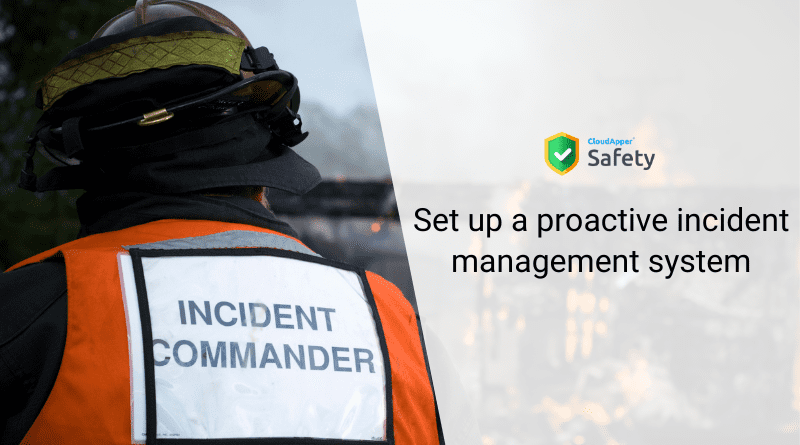According to the Oxford Dictionary, being proactive means taking charge of a situation rather than merely reacting to it after it has already occurred.
Hence, you are aware of what we are discussing!
Finding unexpected incidents, developing a plan, and setting up a system to address and prevent issues are all parts of proactive incident management. Additionally, they help in creating a risk-free safety plan.
We will work with you on establishing proactive rather than reactive incident management. These proactive steps provide a secure environment to prevent incidents.
Let’s quickly explore what may be done to stop incidents.
The Incident Management System
An Incident Management System is needed to plan what to do if something goes wrong during normal operations. It tells the people who should know about it, explains why it’s happening, and suggests a practical way to deal with it.
But if this incident management system supports proactivity, it means you can spot potential risks ahead of time and take steps to avoid them.
Here’s a straightforward example.
Reactive Approach: A person trips over a wire in a dark area. So, the person draws attention to the problem by clicking on the picture of the wire and asking why the light is so dim. They probably only hurt themselves slightly, but it could have been much worse.
Proactive Approach: A safety manager walks around the area and notices the wire in the way and the dim lights. They talk about their worries right away, work on fixing the problem, and resolve it.
This is as simple as A, B, C.
But, the magnitude and intensity of events can vary. So, even though we already have an incident management system in place, we need to make it more proactive.
Proactive Incident Management System
The “zero-incidents” goal is always being worked on by organizations around the world. A proactive incident management system can make a big difference in reaching this goal.
Such a system will help you spot hazards, possible risks, and corrective action plans (CAPAs), which will reduce the risks.
A proactive approach includes:
- The proper planning and execution of daily tasks;
- Maintaining an alert tracking system to notify in real time;
- Providing training through role-play and tabletop exercises;
- Having a quick response team in place.
These methods reduce inefficiencies and improve safety in daily tasks by making sure that each process is clear and easy to understand. These steps also help find trouble spots early and reduce or eliminate the chances of accidents.
With incident management software, the staff can sort through all the paperwork and get back to the tasks that are most important. Also, it helps them stay calm and not freak out if something bad happens.
A proactive incident management system not only answers questions about who, why, where, when, and how, but also changes how businesses prepare for and respond to incidents. The software also recognizes trends and patterns in past events so that the right steps can be taken to make sure they don’t happen again.
How a Proactive Approach Helps
The early detection of risks, holes, trends, mistakes, and problematic areas makes the whole process better and gets rid of them before they get too big to fix. This makes a huge difference in the rate of serious accidents and tells employees to be careful in their daily work.
Here are five steps that show the proactive nature of the incident management system.
Identify/Investigate
When employees can find and report incidents on a central platform, it helps keep track of everything that is going on, so actions are taken on time and the problems are prevented.
Assess
A risk assessment must be done on the reported event, whether it happened or could have been prevented. The software for managing incidents runs a risk assessment to give a score to the event and provide more information about it. These analytics are used to keep the processes from being repeated and to ensure consistency.
Take Appropriate Decisions
Once the incident management system brings up a problem, the people in charge must make the right decisions about it. This quick action could include imposing more training, writing reports, or making plans for doing things right. It also helps you follow the rules and save on fines when things go wrong.
Notify
Good work processes require people to know how to do their jobs. A worker is immediately told by an incident management system if they do something that doesn’t align with normal operations. Also, these systems are set up to make a list for workers that tells them everything they need to know about the tasks they will do. So, notifications are very important for getting the right information to the right people at the right time.
Analyze
The centralized platform and trends make it easier to figure out what’s wrong and what’s causing the issue. It lets teams make plans for both long-term and short-term actions and assign them to the right teams. For example, if there are a lot of accidents in a certain area, training can be given more attention to figure out what’s wrong and how to fix it.
Conclusion
With a proactive incident management system, organizations can:
- Prevent/simplify incident escalations;
- Quickly send related alerts and notifications;
- Monitor trends and help create action plans;
- Keep the stakeholders alert & informed at all stages of an incident;
- Maintain communication across multiple platforms;
- Prioritize ongoing compliance;
- Examine all the potential hazards;
- Leverage new technologies.
A growth mindset can be encouraged at work by taking a proactive approach. Doing so allows people to talk without being afraid, which prevents accidents from happening instantly. It also promotes an open culture and makes processes, products, and services better while keeping people safer.



















